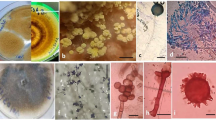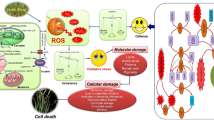Abstract
Aerenchyma formation plays an important role in the survival of Potamogeton perfoliatus in submerged environment. To understand the regulatory role of reactive oxygen species (ROS) and caspase 3-like protein signaling molecules in aerenchyma formation, we investigated the effects of exogenous NADPH oxidase inhibitor (diphenyleneiodonium chloride, DPI), catalase inhibitor (3-amino-1,2,4-triazole, AT), and caspase-3-like protein inhibitor (AC-DEVD-CHO, DEVD) on morphological and physiological characteristics and aerenchyma formation in P. perfoliatus. The results showed that after DPI treatment, caspase-3-like protein activity decreased, ROS-related enzyme activities increased, and H2O2 content decreased, thereby inhibiting aerenchyma formation. When the concentration of DPI was approximately 1 μmol/L, the inhibitory effect was the most obvious. On the contrary, after the AT treatment, caspase-3-like protein activity increased, ROS-related enzyme activities decreased, and the H2O2 content increased, ultimately promoting aerenchyma formation, and the promotion was the most obvious under treatment with approximately 500 μmol/L AT. After DEVD treatment, the inhibition of vegetative growth caused by DPI or AT treatment was alleviated, significantly reducing caspase-3-like activity and inhibiting aerenchyma development. The results of this study show that ROS has a positive regulatory effect on aerenchyma formation, and caspase-3-like protein is activated to promote ROS-mediated aerenchyma formation. This experiment provides a new theoretical basis for further exploration of the signal transduction effects of ROS and caspase-3-like protein in plant cells and their roles in plant development.












Similar content being viewed by others
Abbreviations
- CK:
-
Control
- PCD:
-
Programmed cell death
- ROS:
-
Reactive oxygen species
- DPI:
-
Diphenyleneiodonium chloride
- AT:
-
3-Amino-1,2,4-triazole
- DEVD:
-
AC-DEVD-CHO
References
Apel K, Hirt H (2004) Reactive oxygen species: metabolism, oxidative stress, and signal transduction. Annu Rev Plant Biol 55:373–399
Biswas MS, Mano JI (2016) Reactive carbonyl species activate caspase-3-like protease to initiate programmed cell death in plants. Plant Cell Physiol 57:1432–1442
Bonneau L, Ge Y, Drury GE et al (2008) What happened to plant caspases. J Exp Bot 59:491–499
Chang MY, Wei XN, Wang QY et al (2016) A comparative study on different extraction methods for plant chlorophyll. Chin Agric Sci Bull 32:177–180
Chang ZF, Xian L, Samuel WM et al (2022) Physiological response mechanism of three common submerged plants in plateau to different concentrations of ammonium nitrogen. J Hydroecol 1–13
Danon A, Rotari VI, Gordon A et al (2004) UV-C overexposure induces a programmed cell death in Arabidopsis, which is mediated by caspase-like activities and can be suppressed by caspase inhibitors, p35 and defender against apoptotic death. J Biol Chem 279(1):779–787
Dhindsa RS, Plumb-Dhindsa P, Thorpe TA (1981) Leaf senescence: correlated with increased levels of membrane permeability and lipid peroxidation, and decreased levels of superoxide dismutase and catalase. J Exp Bot 32(126):93–101
Fan MS, Zhang FS (2002) Aerenchyma formation in plant and its physiological and ecological signifi-cance. Plant Physiology Journal 38(06):615–618
Fernández MB, Daleo GR, Guevara MG (2012) DEVD ase activity is induced in potato leaves during Phytophthora infestans infection. Plant Physiol Biochem 61(4):197–203
Ferradás Y, López M, Rey M et al (2014) Programmed cell death in kiwifruit stigmatic arms and its relationship to the effective pollination period and the progamic phase. Ann Bot 114(1):35
Ge ZQ, Yang S, Cheng JS et al (2005) Signal role for activation of caspase-3-like protease and burst of superoxide anions during Ce4+-induced apoptosis of cultured Taxus cuspidate cells. Biometals Int J Role of Metal Ions Biol Biochem Med 18(3):221–232
Gechev TS (2004) Hydrogen peroxide as a signal controlling plant programmed cell death. J Cell Biol 168(1):17–20
Gechev T, Gadjev I, Van BF et al (2002) Hydrogen peroxide protects tobaccofrom oxidative stress by inducing a set of antioxidant enzymes. Cell Mol Life Sci 59(4):708–714
Gechev TS, Breusegem FV et al (2010) Reactive oxygen species as signals that modulate plant stress responses and programmed cell death. BioEssays 28(11):1091–1101
Gill SS, Tuteja N (2010) Reactive oxygen species and antioxidant machinery in abiotic stress tolerance in crop plants. Plant Physiol Biochem 48(12):909–930
Gray J (2012) Programmed cell death in plants. Biochemistry 77(13):1452–1464
Guo YJ (2013). Influence of caspase 3-like proteaseson programmed cell death of endosperm cells in winterwheat (Triticum aestivum. L) under waterlogging. Dissertation, Huazhong Agricultural University
Hatsugai N, Iwasaki S, Tamura K et al (2009) A novel membrane fusion-mediated plant immunity against bacterial pathogens. Genes Dev 23(21):2496–2506
He WK (2017) Research on influence factors of submerged macrophytes restoration in eutrophic water. Dissertation, Wuhan University
Huang WJ, He HY et al (2014) Aluminum induces rapidly mitochondria-dependent programmed cell death in Al-sensitive peanut root tips. Bot Stud 55(1):67
Jing YW, Yi J, Gao F et al (2003) ROS: from toxic molecules to signaling molecules. Chin J Cell Biol 25(4):197–202
Jong AJD, Hoeberichts FA, Yakimova ET et al (2000) Chemical-induced apoptotic cell death in tomato cells: involvement of caspase-like proteases. Planta 211(5):656–662
Keyster M, Klein A, Plessis MD et al (2013) Capacity to control oxidative stress-induced caspase-like activity determines the level of tolerance to salt stress in two contrasting maize genotypes. Acta Physiol Plant 35(1):31–40
Krzymowska M, Sobczak M et al (2010) Infection of tobacco with different pseudomonas syringae pathovars leads to distinct morphotypes of programmed cell death. Plant J 50(2):253–264
Li ZG, Gong M (2008) Improvement of the determination of plant peroxidase activity by guaiacol method. Plant Physiol J 44(2):323–324
Li JL, Yin LY, Chen YY et al (2010) Preliminary study on clustering effect on seed germination for several aquatic plants. Plant Sci J 28(03):330–335
Li Z, Yang H, Wu X et al (2015) Some aspects of salinity responses in peppermint (Mentha×piperita L.) to NaCl treatment. Protoplasma 252(3):885–899
Li N (2017). Diversity and community characteristics of aquatic plants in Qaidam Basin. Dissertation, Hubei University
Liu JX, Howell SH (2010) Endoplasmic reticulum protein quality control and its relationship to environmental stress responses in plants. Plant Cell 22(9):2930–2942
Ma XJ, Zhu DH (2003) Functional roles of the plant superoxide dismutase. Hereditas 25(2):225–231
María RS, Ivett B, Deepak P et al (2012) NO, ROS, and cell death associated with caspase-like activity increase in stress-induced microspore embryogenesis of barley. J Exp Bot 63(5):2007–2024
Mcilwain DR, Berger T, Mak TW (2013) Caspase functions in cell death and disease. Cold Spring Harb Perspect Biol 5(4):a008656
Meng Y (2012) Programmed cell death during cavity formation in the leaf of Typha angustifolia Linn. Dissertation, Northwest University
Mignolet SL, Xu E, NiinaIdänheimo et al (2016) Spreading the news: subcellular and organellar reactive oxygen species production and signalling. J Exp Bot 67(13):311-327
Ni XL, Tan LL, Zhou YF et al (2018) The involvement of programmed cell death in inflated leaf petiole morphogenesis in Trapa pseudoincisa. Funct Plant Biol: FPB 45(4):412–427
Ni X-L (2014) Aerenchyma formation and their relationship to programmed cell death in three plants. Dissertation, Northwest University
Noriyuki H, Kenji Y, Shino GY et al (2015) Vacuolar processing enzyme in plant programmed cell death. Front Plant Sci 6
Parlantib S, Kudahettige NP, Lombardi L et al (2011) Distinct mechanisms for aerenchyma formation in leaf sheaths of rice genotypes displaying a quiescence or escape strategy for flooding tolerance. Ann Bot 107(8):1335–1343
Petrov V, Hille J, Muellerroeber B et al (2015) ROS-mediated abiotic stress-induced programmed cell death in plants. Front Plant Sci 6(69):69
Qiu JL, Jin QL, Wang J (1998) Active oxygen and plant defense responses. Plant Physiol J 1998(1):56-63
Qiu R, Zheng RL (2001) Advances of signal transduction of reactive oxygen species. Prog Biochem Biophys 28(3):287–289
Rakesh K, Sinha, Pavel Pospíšil et al (2016) Bcl-2∆21 and Ac-DEVD-CHO inhibit death of wheat microspores. Front Plant Sci 7(41)
Sandjensen K, Pedersen O, Binzer T et al (2005) Contrasting oxygen dynamics in the freshwater isoetid Lobelia dortmanna and the marine seagrass Zostera marina. Ann Bot 96(4):613–623
Sanmartin M, Jaroszewski L, Rojo RE (2005) Caspases. Regulating death since the origin of life. Plant Physiol 137(3):841–847
Song LL, Zhang Q (2007) Reactive oxygen gene network of plants and its regulation. Chin Bull Life Sci 19(3):346–352
Steffens B, Geske T, Sauter M (2011) Aerenchyma formation in the rice stem and its promotion by H2O2. New Phytol 190(2):369–378
Steffens B, Steffen-Heins A, Sauter M (2013) Reactive oxygen species mediate growth and death in submerged plants. Front Plant Sci 4(6):179
Sun YL, Zhao Y, Hong X et al (1999) Cytochrome c release and caspase activation during menadione-induced apoptosis in plants. FEBS Lett 462(3):317
Vacca RA, Valenti D, Bobba A et al (2006) Cytochrome c is released in a reactive oxygen species-dependent manner and is degraded via caspase-like proteases in tobacco bright-yellow 2 cells enroute to heat shock-induced cell death. Plant Physiol 141(1):208–219
Van BF, Dat JF (2006) Reactive oxygen species in plant cell death. Plant Physiol 141(2):384–390
Wang X (2012) The characteristics of reproductionof three submerged macrophyte. Dissertation, Inner Mongolia Agricultural University
Wang X, Li QF, HY et al (2011) Study on some submerged plant asexual reproduction in hetao irrigation area. Environ Dev 23(6):64-67
Wang X, Li QF, Hu Y et al (2013) Seeds dormancy and germination behavior of three submerged macrophytes in the hetao irrigation area of the inner mongolia, China. J Lake Sci 25(001):115–118
Wang SB, Xu ZR, Zhang J (2016) Dynamic changes of higher submerged macrophytes in Dianchi Lake in recent 50 years and implication for ecological restoration. Water Resour Protect 32(6):6
Wang C, Li L, Ni XL et al (2018) Study on the developmental anatomy of structures and aerenchyma formation in Potamogeton perfoliates stems and leaves. Acta Botan Boreali-Occiden Sin 38(07):107–115
Xiao DR, Yuan H, Tian K et al (2012) Distribution patterns and changes of aquatic communities in lashihai plateau wetland after impoundment by damming. Acta Ecol Sin 32(03):815–822
Yamauchi T, Rajhi I, Nakazono M (2011) Lysigenous aerenchyma formation in maize root is confined to cortical cells by regulation of genes related to generation and scavenging of reactive oxygen species. Plant Signal Behav 6(5):759–761
Yamauchi T, Watanabe K, Fukazawa A et al (2014) Ethylene and reactive oxygen species are involved in root aerenchyma formation and adaptation of wheat seedlings to oxygen-deficient conditions. J Exp Bot 65(1):261–273
Yamauchi T, Yoshioka M, Fukazawa A et al (2017) An NADPH oxidase RBOH functions in rice roots during lysigenous aerenchyma formation under oxygen-deficient conditions. Plant Cell 29(4):775–790
Yao S, Huang W, Pan C et al (2016) Caspase-like proteases regulate aluminum-induced programmed cell death in peanut. Plant Cell, Tissue and Organ Culture (PCTOC) 127(3):691–703
Zhang L, Xu Q, Xing D et al (2009) Real-Time detection of caspase-3-Like protease activation in vivo using fluorescence resonance energy transfer during plant programmed cell death induced by ultraviolet C overexposure. Plant Physiol 150(4):1773–1783
Zhang SQ (2017) Study on aquatic plants diversity and community characteristics in hexi corridor. Dissertation, Hubei University
Zhang DY (2018) Relationship between PCD and ROS metabolism and NO synthesis in somatic embryögenesis of fraxinus mandshurica. Dissertation, Northeast Forestry University
Author information
Authors and Affiliations
Corresponding author
Ethics declarations
Conflict of interest
The authors declare no competing interests.
Additional information
Communicated by Handling Editor: Peter Nick
Publisher’s note
Springer Nature remains neutral with regard to jurisdictional claims in published maps and institutional affiliations.
Rights and permissions
About this article
Cite this article
Xie, Q., Yuan, Z., Hou, H. et al. Effects of ROS and caspase-3-like protein on the growth and aerenchyma formation of Potamogeton perfoliatus stem. Protoplasma 260, 307–325 (2023). https://doi.org/10.1007/s00709-022-01780-z
Received:
Accepted:
Published:
Issue Date:
DOI: https://doi.org/10.1007/s00709-022-01780-z




